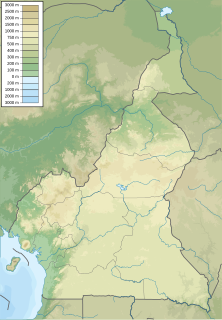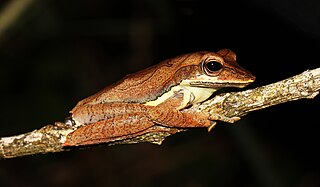Nectophrynoides minutus is a species of toad in the family Bufonidae. It is endemic to Tanzania and is known from the Uluguru and Rubeho Mountains. Common names small viviparous toad, minute tree toad, and dwarf forest toad have been proposed for it.

Hyperolius jynx is a species of frog in the family Hyperoliidae. It is endemic to the Rumpi Hills in south-western Cameroon. The common name smooth egg-guarding frog has been proposed for this species.
Craugastor adamastus is a species of frog in the family Craugastoridae. It is endemic to Guatemala and only known from its type locality near Aldea Vista Hermosa, on the northern slopes of the eastern portion of the Sierra de las Minas, where the type series was collected in 1980–1981.

Pristimantis yaviensis is a species of frog in the family Craugastoridae. It is endemic to Venezuela and known from its type locality, the summit of Cerro Yaví, a sandstone table-top mountain (tepui), and from Cerro Yutajé, both in the Amazonas State. The specific name yaviensis refers to the type locality.

Phrynobatrachus cricogaster is a species of frog in the family Phrynobatrachidae. It is found in the mountains of western Cameroon and southeastern Nigeria. Common name Nkongsamba river frog has been coined for it. The specific name cricogaster is derived from the Greek krikos for "ring" and gaster for "belly", in reference to the prominent ring pattern on its venter.
Phrynobatrachus dalcqi is a species of frogs in the family Phrynobatrachidae. It is endemic to the eastern Democratic Republic of the Congo and only known from Fizi Territory in the South Kivu province. The specific name dalcqi honours "Professor A. Dalcq", presumably Albert Dalcq (1893–1973), a Belgian embryologist. Common names Kivu river frog and Dalcq's puddle frog have been proposed for it.
Phrynobatrachus gastoni is a species of frog in the family Phrynobatrachidae. It is endemic to the north-central Democratic Republic of the Congo and only known from its type locality, Buta. The specific name gastoni honours Gaston-François de Witte, a Belgian colonial administrator and naturalist who scrutinized the types. Common name Buta river frog has been coined for it.
Phrynobatrachus hylaios is a species of frog in the family Phrynobatrachidae. It is known from southern Cameroon and western Republic of the Congo, although its range presumably extends into nearby Central African Republic, Equatorial Guinea, and Gabon. It was first described as a subspecies of Phrynobatrachus werneri. The common name Foulassi river frog has been coined for it.
Phrynobatrachus keniensis is a species of frog in the family Phrynobatrachidae. It is found widely in the highlands of Kenya. It is also recorded from Mount Meru in northern Tanzania, but this might represent a different species. Common names Kenya River frog and upland puddle frog have been coined for it.
Phrynobatrachus krefftii is a species of frog in the family Phrynobatrachidae. It is endemic to the Usambara Mountains in Tanzania, including both the West and East Usambaras and the Magrotto ridge. The specific name krefftii honours Paul Krefft, a German herpetologist and physician who made several expeditions to Africa. Common names Krefft's river frog and Krefft's puddle frog have been coined for it.

Phrynobatrachus minutus is a species of frog in the family Phrynobatrachidae. It is endemic to Ethiopia and occurs in the central and southern parts of the country on both sides of the Rift Valley; its range may extend south to Kenya, perhaps further. Some earlier records from Ethiopia represent Phrynobatrachus inexpectatus, described as a new species in 2001. The specific name minutus refers to the small size of this frog. Common names tiny river frog and Ethiopian dwarf puddle frog have been coined for it.
Phrynobatrachus ogoensis is a species of frog in the family Phrynobatrachidae. It is endemic to Gabon and is known from its type locality, Lambaréné in the Moyen-Ogooué Province, and from the Ramba Village in the Ogooué-Ivindo Province, in the buffer zone of the Lopé National Park.
Phrynobatrachus rungwensis is a species of frog in the family Phrynobatrachidae. It is found in southeastern Democratic Republic of the Congo, central and northern Malawi, and east to southern and central Tanzania. It is also expected to occur in northeastern Zambia. Common names Rungwe puddle frog and Rungwe river frog have been coined for it. It is named after Mount Rungwe, its type locality.
Phrynobatrachus sulfureogularis is a species of frog in the family Phrynobatrachidae. It is known from the Massif of Nanzergwa, its type locality in the Bururi Province of western Burundi, and from the Mahale Mountains National Park in eastern Tanzania. The specific name sulfureogularis is derived from the Latin sulfur that refers to the element that is yellow in color and gula meaning throat, in reference to the bright yellow throat in breeding males. Common name central river frog has been coined for it.
Phrynobatrachus taiensis is a species of frog in the family Phrynobatrachidae. It is endemic to Ivory Coast and only known from its type locality, Taï Forest in the Taï National Park. There are concerns about taxonomic validity of this species. Common name Tai river frog has been coined for it.
Phrynobatrachus ukingensis is a species of frog in the family Phrynobatrachidae. It is recorded in several places in southern and eastern Tanzania and in northern and southern Malawi ; it probably occurs more widely, at least in areas in between the known localities. Common names Ukinga puddle frog and Ukinga river frog have been coined for it.
Phrynobatrachus uzungwensis is a species of frogs in the family Phrynobatrachidae. It is endemic to eastern Tanzania and is known from the Udzungwa, Uluguru, Nguu, and Nguru Mountains. Common names Ukinga puddle frog and Udzungwa puddle frog have been coined for this species.

Taruga fastigo is a species of frogs in the family Rhacophoridae. It is endemic to Sri Lanka and only known from its type locality, Morningside Estate near Rakwana. Prior to its description in 2001, it was confused with Polypedates eques.

Phrynobatrachus njiomock is a species of frogs in the family Phrynobatrachidae. It is endemic to Cameroon and is only known from Mount Oku where it occurs near Lake Oku. It has not been observed after 2010 and might already be extinct. The specific name njiomock means "eleventh" in Oku language and refers to the name "Phrynobatrachus sp. 11" that Jean-Louis Amiet used in 1978 to refer to a specimen collected near Lake Oku. Common name Lake Oku puddle frog has been proposed for this species.

Phrynobatrachus jimzimkusi is a species of frogs in the family Phrynobatrachidae. It is found in submontane and montane regions within the Cameroon volcanic line as well as the adjacent Obudu Plateau in the southeast of Nigeria. It is named after James (Jim) Zimkus by his wife, Breda Zimkus, the first author of the species description. Common name Jim Zimkus' puddle frog has been proposed for this species.






